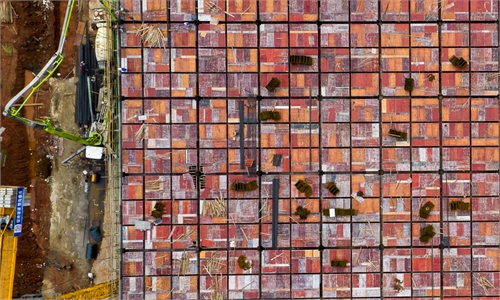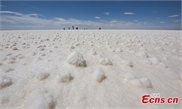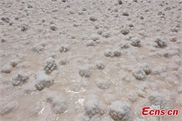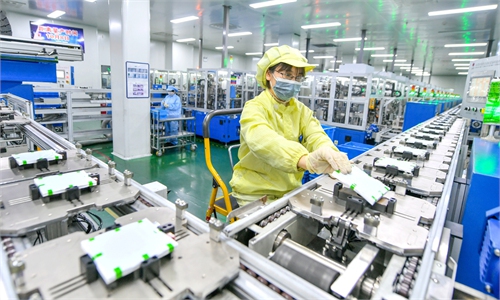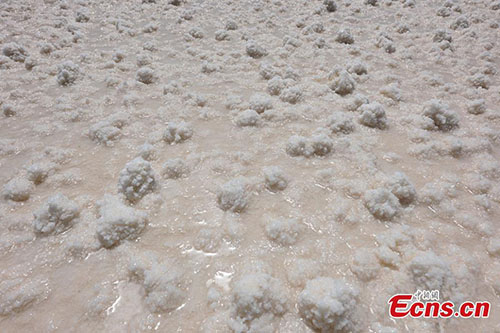
A view of the Qarhan salt lake in Golmud, Northwest China's Qinghai Province, July 25, 2018. The Qarhan salt lake, with a total area of 5,856 square kilometers, is the largest salt lake in China. The lake's abundant deposit of halide salts makes it a major mineral center. In the vast lake, the salt blossoms like flowers and takes the form of pillars, corals and pearls. (Photo: China News Service/Fu Yu).
With stocks related to lithium continuing to rise on the A-share market due to the good outlook for lithium battery and electric vehicle (EV) products, the Economic Daily commented on Monday that the risk of a valuation bubble should not be ignored, particularly in concept stocks such as lithium extraction from salt lakes.
However, stocks related to lithium extraction from salt lakes still closed 3.07 percent higher on Monday, with shares in Ganfeng Lithium Co, Shenzhen Sunrise New Energy Co and Tibet Mineral Development Co all rising by the daily limit of 10 percent.
Since August, the Shanghai and Shenzhen stock exchanges have sent letters of concern to a number of listed companies regarding improper practices related to lithium batteries.
There is a total of 36 salt lake lithium-themed funds, which all recorded positive growth this year, with the average yield reaching 34.97 percent, according to financial data terminal iFinD.
Market observers said that lithium is indeed a good concept to invest in, but investors should be cautious about companies' announcements related to investment, construction or development.
"The earnings of the stocks and funds depend on the performance of listed companies. At present, the performance of relevant lithium companies is not as good as expected. Most companies engaged in lithium extraction from salt lakes are only making a little or are even making a loss," an independent investor surnamed Cheng, told the Global Times on Monday.
Cheng noted that such performance indicated the immature level of extraction technology in the industry.
Lithium is a metal, once regarded as "white oil" because of its important role in the field of EVs as the crucial upstream raw material for batteries.
According to the latest data from the International Energy Agency, the world will have a lithium supply shortfall of about 50 percent by 2030 from existing and ongoing lithium production projects.
"It is expected that the global lithium demand will double from the current 500,000 tons to 1-1.3 million tons by 2025," an EV industry insider surnamed Zhang told the Global Times on Monday.
The lithium used in EVs accounts for about 50 percent of the current application of lithium, while the traditional 3C industry - computers, communication and consumer electronics - takes the other 50 percent. Lithium resources are also widely used in glass and ceramics, medicine, fuel and catalyst fields, Zhang noted.
According to the China Automobile Association, the sales volume of new-energy vehicles, including EVs, in China in 2020 was 1.367 million. The sales reached 1.206 million in the first half of 2021.
Considering the expanding EV market, domestic lithium production is struggling to meet the demand. China is about 70 percent reliant on imports, Zhang added.
Although China has lithium reserves of about 4.5 million tons, accounting for 6 percent of the global total, the amount of usable lithium resources is only 1 million tons, accounting for 5.6 percent in the world, according to statistics from the US Geological Survey.
The lithium resources in China mainly come from salt-lake brine and hard rock ore - spodumene and lithium mica. Salt lakes are mainly distributed in Northwest China's Qinghai Province, Southwest China's Tibet Autonomous Region and Central China's Hubei, accounting for about 81.6 percent of the lithium reserves in China, according to data from the China Geological Survey.
Spodumene ores are mainly distributed in Southwest China's Sichuan Province, accounting for 10.9 percent, and lithium mica mainly in East China's Jiangxi Province, accounting for 7.5 percent.
"Lithium extraction from salt lakes has not entered the stage of large-scale application in China. But it has broad application prospects, once the industrial technology is mature enough to enable mass production," said Zhang.
Data shows that 90 percent of the lithium carbonate used in batteries in China still uses ore as a raw material, while more than 60 percent of the world's lithium products are obtained from salt-lake lithium.
Zhang also noted that exploration of salt-lake lithium in China faces two main challenges.
"Since China's lithium salt lakes are mainly distributed in Qinghai and Tibet, it is It is difficult and expensive to build infrastructure on the Qinghai-Tibet Plateau, as the fragile local ecosystem could be damaged," said Zhang.
What's more, the concentration of lithium in salt-lake brine in China is low, and the ratio of magnesium to lithium is high, Zhang added, with more magnesium meaning less lithium.
"If China wants to extract lithium from salt lakes on a large scale, it involves extraction, calcination and other processes," Zhang said.
But Chinese enterprises are developing relevant technologies and are investing in exploration of salt lakes.
Tibet Mineral Development Co announced Thursday that it will invest 2 billion yuan ($309.1 million) to develop the Zhabuye salt lake in Tibet. The project is expected to be up and running in 2023.
